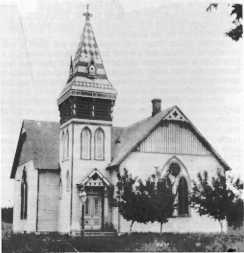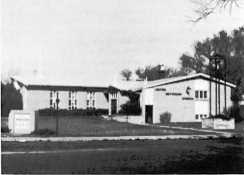|
|
United Methodist
Church
(Written by J. D.
Bell in 1948)
Before there was any town of Bellwood
Church and Sunday School were held in the Girrard school
house which was located 3/4 miles west of the farm home of
Sadie Wagner. The first preacher there was B. S. Taylor
(Sept. 22, 1875 to May 1877) followed by Rev. Nunnely, Cook,
Fleharty, and Bristol, all of whom were on the Columbus
Circuit. Leading church members were the Girrards, Lillies,
Burchs, Hills, Warrens, Wilsons, Bells and others. C. W.
Derby was prominent as an "exhorter" and leader in the
meetings. J. D. Bell, Sr., was the teacher of the Bible
class in this school house. (I have a Bible presented to my
father at this school house on Dec. 24, 1879 by his
class).
In 1881 Bellwood got its first preacher,
Rev. Alberry, followed in 1882 by L. C. Lemon and in 1883 by
Rev. Redkey. After 1881 Church and Sunday School were held
in "Bell's Hall," which was the hall over the Bell General
Store recently torn down to make room for the present Oil
Co. station.
Among the Sunday School teachers in this
hall were Matilda, Mary, and Ella Watson, Linnie Warren, J.
D. Bell, Sr., Lena Bell, Ella Derby, Mrs. Hill and others.
Many fine sessions of Sunday School and Church were held up
in this hall and Christmas trees and programs never to be
forgotten. It was not too easy for the older people to climb
the many steps to get up there and besides the hall was not
large enough to seat all the people.
In 1884 Rev. J. D. M. Buckner was the new
preacher sent to Bellwood. In early 1885, he, Thomas
Wimberly and J. D. Bell were appointed a committee of three
to raise money to build a church. The times were not good
and most people were rather hard up. However, enough money
was raised and the 30' x 50' church was erected that year on
the lots which had been donated. A tall 12' x 12' tower was
erected at the southeast corner of the building which
provided the belfry for the new bell and an entry way into
the church. The ladies of the church raised the money to
purchase the bell.
The largest increase in membership
occurred during the pastorate of Rev. L. F. Smith from 1892
to 1896. Although there were poor crops, and hard times
during the 90s many people joined the church who had not
been interested before in such things. And it was during
these hard times that the 16' x 30' south wing was added on
the building. Nearly everyone helped with money, such as
they had. Those who had no money worked day after day on the
building as their contribution.
The church was heated by stoves and
lighted by large kerosene lamps. Later the lamps were
replaced with acetylene gas, and now by electricity. It is
now heated by a furnace fired by an automatic electric coal
stoker.
The old chairs were taken out years ago
and replaced by the oak pews purchased with money left to
the church in the will of Maria Williams.
Up to the time of his death in 1889 J. D.
Bell, Sr., was superintendent of the Sunday School. The
early teachers were Mary and Ella Watson, Linnie Warren, Ada
Taylor, George Simms, Mrs. Neely, Minnie French, Mrs.
Austin, Jennie Hager and others.
After 1948
The Methodist Youth Fellowship (MYF)
which began in the 1940s continued on as a strong program
through the 1950s. This group carried out many projects that
were beneficial to the church and the community.
In the years 1961 and 1962 during the
pastorate of Rev. Melvin Cammack much consideration was
given to renovating the church and building on classrooms.
An architect was engaged to draw up preliminary plans and
cost estimates, for this work. It soon became evident that
it might be more practical to build a new church than to
spend a large sum on remodeling. On March 22, 1963 at the
annual church meeting of the congregation it was voted to
proceed on the plans for a new church. In June 1963 Rev.
Lloyd Mohnkern
|
|
was assigned as pastor. In January 1964 a financial
crusade was held and adequate money was pledged to proceed
with construction. The ground breaking ceremonies were held
on Aug. 9, 1964.
The first service was held in the new
church Oct. 10, 1965. The consecration service was held Nov.
7, 1965 with Bishop Copeland officiating and District
Superintendent McCamley and Rev. Mohnkern participating. All
indebtedness was paid by January 1970 and the dedication
service was held on May 17, 1970.
The present pastor is Kenneth Rood.

Methodist Church.

Bellwood
United Methodist Church erected in 1965.
Bellwood
Cemetery
Although the earliest burials in the
Bellwood cemetery date back to 1871, there was no formal
organization until Sept. 1, 1881, when nine men organized
the Bellwood Cemetery Association. This first meeting was
held in the Bellwood Post Office after giving the required
20 day notice of their intention to form such an
association. Present at this meeting were J. D. Bell,
Charles W. Derby, J. H. Derby, Godfrey Marti, Fred Marti,
John Kellogg, Frank Beard, C. S. Burch and E. F.
Hutchison.
|
|